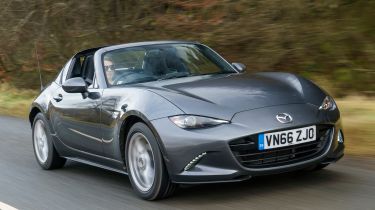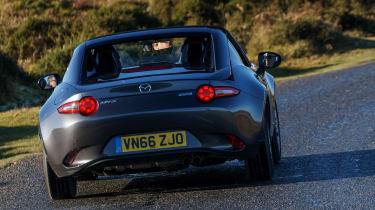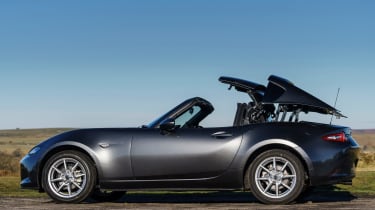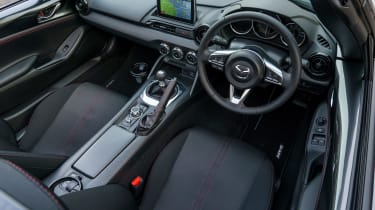New Mazda MX-5 RF 1.5 2017 review
Trick metal-roofed Mazda MX-5 RF is a well-rounded package, but this 1.5-litre car isn't quite punchy enough to disguise the extra weight

Our first drive of the new MX-5 RF showed us that by fitting a trick metal roof, the two-seat sports car had lost none of its renowned Mazda magic. However, while the larger 2.0-litre coped well with the added weight, the penalties are more pronounced in the 1.5 – making it just that bit more difficult to get the best out of the sweet chassis. It’s still a well-rounded and effective package, but we’d recommend spending the extra £900 on the more powerful car.
The Mazda MX-5 is the world’s best-selling two-seat roadster. Since launching in 1989, the Japanese brand has sold more than one million of the rear-wheel-drive sports cars – with over 120,000 finding homes in the UK.
Part way through its third generation, Mazda introduced an MX-5 with a folding metal roof – designed to complement its soft-top sibling by offering improved refinement for those regularly undertaking longer motorway journeys. Much to Mazda’s surprise, the hard-top MX-5 actually outsold the fabric-roofed car four to one.
The formula has been adapted somewhat for the Mk4 MX-5, and while we first drove the tin-top RF last month in high-spec 2.0-litre Sport Nav trim – it’s the more modest 1.5 that we’re trying back here in the UK.
Suffice to say it looks just as special in dark and dreary Devon as it did in the Spanish sun. Unlike its predecessor, the RF offers a dramatically different profile to the normal MX-5, while the origami roof gives it a sense of occasion comparable to Porsche’s latest 911 Targa.
Used - available now
We praised the RF almost unreservedly when we tested it previously; commending its agile, approachable and gratifying handling – ultimately awarding it the full five stars. The slight trade off in performance due to the added weight of the folding roof was barely noticeable, while the rigid yet forgiving chassis of the soft-top remained intact.
However, the additional 40kg brought about by the Mazda’s new metal lid is much more noticeable in the lower-powered car. The 129bhp 1.5-litre SkyActiv engine is our pick of the standard MX-5 range, but in the RF it feels less responsive and – with two people and a couple of bags on board – needs to be worked hard to make decent progress.
The 0-62mph sprint takes 8.6 seconds, which is three-tenths slower than in the soft-top. In contrast, the 158bhp 2.0-litre RF is only a tenth of a second off the pace compared to its fabric-roofed sibling. The difference is more marked on the road, however, forcing you to change down for steeper inclines – or better plan tight overtaking manoeuvres that would otherwise seem simple in the faster car.
We’ve no complaints with the slick six-speed gearbox, but given that the 2.0-litre costs just £900 more, we think it’s worth the extra few pounds per month on one of Mazda’s competitive finance deals.
With the roof up, Mazda claims the new RF offers drivers an extra dose of comfort and refinement, and while it’s definitely quieter than the standard car, there’s still a bit of a whistle around the top of the side windows where the wind catches on the roof. Lower the fully automatic top in just 13 seconds and those fixed rear buttresses create a fair amount of turbulence, but that’s forgotten about when you find yourself feeding the MX-5 through a series of tight bends. That’s where this car comes alive.
The chassis is as taut and responsive as ever. The steering has been tweaked and the suspension stiffened – but luckily the latter doesn’t translate to a bumpy ride on rough British B-roads. There’s enough cushioning in the RF’s setup without it feeling wallowy or uncontrolled – especially on the smaller wheels of our 1.5 SE-L Nav test car.
Commanding a premium of around £2,000 over the soft-top, the cheapest RF you can buy is the well-specced SE-L model we have here. All cars get climate control, cruise control, 16-inch wheels and LED headlights. A seven-inch infotainment screen with sat-nav, Bluetooth and DAB is also included. That should be all the toys you’ll ever need, though for £2,600 you can upgrade to the Sport Nav with rear parking sensors, a Bose stereo and heated leather seats, as well as some extra soft-touch trim for the dash and centre console.
The cabin is still small, and taller drivers will struggle to get truly comfortable given the lack of reach adjustment in the steering wheel. Cabin practicality is almost non-existent – with no door bins or glovebox and just small cubby between the seats. The 130-litre boot is useable enough, however.















